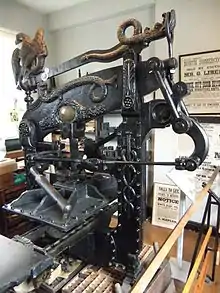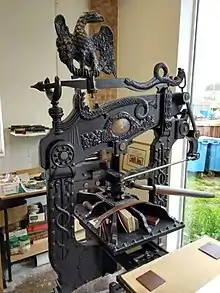Columbian press
The Columbian press was invented by George Clymer, probably in 1813, inspired in some measure by the earlier Stanhope press. It was designed to allow large formes, such as a broadsheet newspaper page, to be printed at a single pull. The press worked by a lever system, similar to that of the Stanhope press and quite different from the toggle action of the slightly later English Albion press. Clymer's new iron press was first advertised in April 1814.

Although Clymer manufactured and sold a few presses in America, he found the market difficult and moved in 1817 to London, where he began a successful manufacturing programme that lasted well into the twentieth century, initially with operations at 1 Finsbury Street, London.[1] In 1830, Clymer joined in a partnership with Samuel Dixon, trading as Clymer, Dixon and Co and moving down the street to 10 Finsbury Street, London.[1] Clymer pursued various business partnerships between 1830 and 1849 before dissolving the partnership; in 1851, the business was taken over by William Carpenter, the first of many takeovers. Nonetheless, the Columbian press continued to be manufactured into the twentieth century and was also manufactured in various European industrial centres.
The press is sometimes, incorrectly, referred to as the 'Eagle' press due to the characteristic bald eagle counterweight which usually sits on the top lever. Some Columbians have the counterweight in another form; for example, a simple ornament, a lamp, urn, or orb.


References
- "Clymer, Dixon and Co". Grace's Guide. Retrieved 4 July 2018.
- Moran, James (1969). "The Columbian press". Journal of the Printing Historical Society (5): 1–23, plates 1–17.
- Oldham, Robert (2014). "The Columbian press at 200: a preliminary report on a world-wide census". Journal of the Printing Historical Society (N.S. 21): 51–66.
External links
| Wikimedia Commons has media related to Columbian presses. |
- Columbian press in the collection of the Smithsonian Institution
- Columbian press in the collection of the Museum of New Zealand Te Papa Tongarewa
- Columbian press in the collection of the Science Museum, London
- Printing Yesterday and Today
- International Printing Museum website
